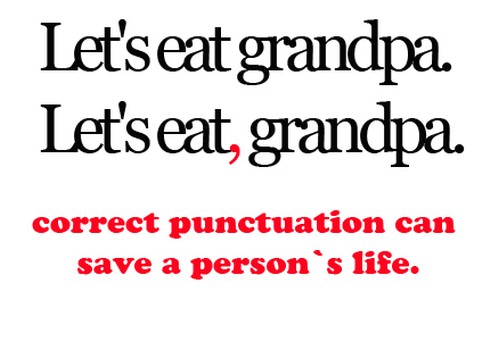Let's Pause To Honor The Comma! - The Grammar-Us Blog - Grammar-Us
Main menu:
Let's Pause To Honor The Comma!
 About ten months ago, I arrived, kicking and screaming, into the 21st century, when I purchased my very first “smart phone.” For six months after that, I mocked that phone as being not as “smart” as advertised, for the simple reason that it did not appear to have a COMMA on its keyboard! I later found it, sequestered from the rest of the punctuation marks. I haven’t decided yet if the manufacturer placed the comma there, because they thought it would be more readily accessible, or because it was a place that no one would look for it! Whatever the reason, I was thrilled when I finally found it; it was like being reunited with a long-
About ten months ago, I arrived, kicking and screaming, into the 21st century, when I purchased my very first “smart phone.” For six months after that, I mocked that phone as being not as “smart” as advertised, for the simple reason that it did not appear to have a COMMA on its keyboard! I later found it, sequestered from the rest of the punctuation marks. I haven’t decided yet if the manufacturer placed the comma there, because they thought it would be more readily accessible, or because it was a place that no one would look for it! Whatever the reason, I was thrilled when I finally found it; it was like being reunited with a long-
Commas are second only to periods in their usefulness. They add clarity to sentences.They can even change the meaning of sentences, depending on whether they are inserted or omitted. Just take a look at the illustrations I’ve included in this post. As you can readily see, the comma makes or breaks the sentences.
The simplest description of the purpose of a comma is that it is a pause. One of my English teachers told us that, when reading a sentence aloud, you know a comma needs to be inserted whenever you need to pause to take a breath. Although that may not be strictly accurate, there are some definite times and places in which commas are necessary. I will list just a few of them here, with the hope that you will do a bit of research to learn other uses for the comma and begin to use it to its full potential. If you do so, I think you’ll find your writing will be much more clear and effective.
1. To separate items in a list. (Example: The vegetable choices were potatoes, corn, peas, and carrots.) The longer the list, the more important commas become in helping break it down and decipher it. This is especially true if the list is made up of multiple words, because it helps to group them properly. An example of this is: Our departments include research and development, marketing and public relations, and human resources.
There are two schools of thought regarding whether a comma is needed preceding the penultimate item in a list (the one immediately preceding the “and”). Back in the Dark Ages when I went to school, we were taught to include the comma. That is called a “serial comma” or “Oxford comma.” Nowadays, some folks do not see a need for it and lobby against using it.
In the first example sentence above, adding a comma just before the “and” would completely change the list. Instead of “peas” and “carrots” being two separate menu items, without the comma, it could be interpreted that the dish is a combination of both veggies. This is an example in which the “Oxford comma” comes in very handy!
2. Separating adjectives. (Example: She is a smart, pretty girl with a lot of potential.) Adding the comma between the two descriptors helps to clarify this girl’s attributes, and perhaps even emphasize them.
3. Separating two independent clauses. (Example: We drove to Elmira, but we took the train on the return trip.) First, a definition of “independent clause” may be in order. Simply put, an independent clause contains its own subject and verb and could stand alone as a sentence in its own right. In the example sentence, “We drove to Elmira” is one independent clause. “We took the train on the return trip” is the second independent clause. They are linked together with the connecting word “but.” Therefore, a comma should be inserted before the word “but.”
4. Setting off a dependent clause. (Example: While making the bed this morning, I found a hole in the sheet.) A dependent clause is one that cannot stand alone, because it does not have one of the essential elements of a complete sentence, either the subject or the verb. In the above example, the dependent clause is “While making the bed this morning.” Since there is no subject in this clause, it is dependent on the rest of the sentence, which does contain a subject, in order to make sense. As a dependent clause, it needs the comma after “morning.” 5. Addressing a person or setting off a description of the subject of a sentence. (Example: Let’s eat, Grandpa!) In this example, I am addressing my grandfather. The comma is very necessary here, because without it, the sentence would state that I am EATING my grandfather, rather than calling him to dinner! An example of setting off a description of the subject is the following example: Jeremy, the park ranger, warned us that there were bears in the area. The commas separating “the park ranger” help to clarify that this phrase is a descriptor of Jeremy.
5. Addressing a person or setting off a description of the subject of a sentence. (Example: Let’s eat, Grandpa!) In this example, I am addressing my grandfather. The comma is very necessary here, because without it, the sentence would state that I am EATING my grandfather, rather than calling him to dinner! An example of setting off a description of the subject is the following example: Jeremy, the park ranger, warned us that there were bears in the area. The commas separating “the park ranger” help to clarify that this phrase is a descriptor of Jeremy. BONUS TIP:
BONUS TIP:
As much as I love commas, and as adamantly as I feel that they enhance the effectiveness of written communications, even I have to admit that there are times when a comma is NOT appropriate! One of these is when a comma has been inserted in a place where a period is actually the proper punctuation mark. Here’s an example of this: Miriam took the day off, she had a headache and needed rest.
In this example, there is no connector word between the first independent clause (“Miriam took the day off”) and the second independent clause (“she had a headache and needed rest.”) Therefore, they actually should be treated as two separate sentences, punctuated by periods. (Miriam took the day off. She had a headache and needed rest.) Alternatively, a connector word could be added, in which case the comma would be appropriate. (Miriam took the day off, because she had a headache and needed rest.)
- FRESH WRITING
- TWELVE ERRORS THAT MAKE A GRAMMARIAN GNASH HER TEETH
- THE WHYS AND HOWS OF WRITING AN EFFECTIVE CONSUMER LETTER
- FILLER WORDS: THE "JUNK FOOD" OF COMMUNICATIONS
- Pardon Me, Your Participle is Dangling!
- MAKE BETTER GRAMMAR A NEW YEAR’S RESOLUTION
- The Value Of Personal Letters
- How To Make Your Writing Flow
- How (And Why) To Tighten Up Your Writing
- Why Grammar Matters
- Time For Another Grammar Quiz!
- Editing: The "Make Or Break" Skill
- Proofreading: It Matters More Than You Think!
- Please Don't Ruin A Perfectly Good Tense!
- A Brave New Word
- Homophones: The Sequel
- Coulda, Shoulda, Woulda And Other Incorrectly Written Words
- More Homophones
- Time For Another Grammar Goof Quiz
- A Different Kind Of Colonoscopy (And Semi-Colonoscopy)
- Comparatives & Superlatives: The Good, The Bad, And The Ugly
- Either/Or, Neither/Nor: Decisions, Decisions!
- Let's Agree To Agree
- Avoiding Apostrophe Apocolypse
- Let's Pause To Honor The Comma!
- Three Speech Patterns That Can Compromise Professionalism
- A Hit Parade of Grammar Misses
- Negative Nancy Has Hijacked My Blog!
- Who Dat?
- Avoiding the Ill Effects of Misusing "Affect"
- How To Perfectly Use Six Irregular Verbs
- Random Ramblings
- Me, Myself and I: The Narcissist's Nightmare
- Confounding Compounds
- "All The World's A Stage...": Know Your Audience
- From The Department Of Redundancy Department: The Whole Entire Scoop On "Whole" And "Entire"
- Grammatically Challenged? There, Their, They're. It'll Be OK!
- "Its": It's a Special Exception
- We're Up And Running!